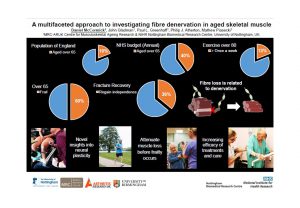
March 10, 2020, by aeyavb
Neural adaptations to acute muscle damage in younger and older adults (AMD)
Muscle force relies on a combination of altered motor unit (MU) firing rates and recruitment through an increasing range of sizes. However, alterations in these mechanisms may influence muscle functional decline when in a fatigued and damaged state.
Although eccentric exercise provokes more significant loss of function, muscle damage and soreness than concentric exercise, it is not clear how these forms of exercise may impact the size of MU recruited to achieve a given force. Therefore, Daniel McCormick and Dr Mathew Piasecki are conducting a study to investigate how eccentric/concentric exercises influence the size of Motor Units.

They applied the ‘Step Up, Step Down’ exercise technique on 8 untrained healthy young adults. This was designed to induce eccentric and concentric exercise in opposing quadriceps.
Functional decline and muscle damage were assessed by identifying maximal voluntary isometric contraction (MVC) and serum creatine kinase. Intramuscular electromyography was then used to sample individual motor units during isometric contracts held at 25% MVC, with the area of the motor unit potential being used as an indicator of motor unit size. All measures were performed at baseline, post-exercise and 48 hours post-exercise.
Results:
Creatine kinase increased from baseline to post-exercise, and the mean value remained elevated at 48 hours post-exercise compared to baseline.
In the concentric limb, MVC was reduced immediately post-exercise, but there was no significant change at 48 hours post-exercise when compared to baseline. Similarly, motor unit potential (MUP) area was reduced immediately post-exercise and continued 48 hours post-exercise.
In the eccentric limb, MVC also reduced immediately post-exercise, and remained significantly reduced 48 hours post-exercise. However, unlike the concentric limb, the change in MUP area in the eccentric limb did not correspond with the prolonged reduction in MVC immediately post and 48 hours post-exercise, which returned to near baseline values.
Conclusion:
The restoration of the MU size suggests that in healthy young adults the recruitment strategy can recover after a significant eccentric-exercise induced disturbance, however, the recovery is not equalled by force producing ability. Changes in MUP area did not differ between the two exercise conditions at either points tested, however, the expected differences in muscle function were observed. Therefore, this data is highly suggestive of a minimal relevance in motor unit size recruitment strategies in the observed functional decline following eccentric exercise.

Daniel and Mathew are currently recruiting healthy men and women aged 18-35 and over 65 years to participate in this study. They hope to be able to provide novel and mechanistic insights into the altered functional recovery observed in older adults, and explore potential differences between men and women.
Amelia Bell
No comments yet, fill out a comment to be the first

Leave a Reply